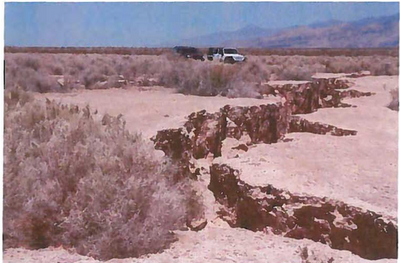BLM Voices Concerns Over BrightSource Water Use
BLM sent a letter to the California Energy Commission (CEC) this month recommending stronger measures to mitigate or monitor BrightSource Energy's proposed Hidden Hills Solar project. If approved, the project would be built in the Pahrump Valley next to th California-Nevada border, and draw an estimated 227.1 million gallons of water during a 29-month construction period, and 45.6 million gallons each year during operation. Groundwater is already severely overdrawn in the Pahrump Valley, causing subsidence in the land that may ultimately reduce. the amount of water that can be stored.
BLM provided the following photo of large cracks in the land near the proposed Hidden Hills solar site-- an indication of subsidence resulting from overdrawn groundwater.
In its submission to the CEC, BLM noted that simply requiring BrightSource to replace extracted water at some point over the expected 30 year life of the project may not be sufficient given the current severity of groundwater shortages in the Pahrump Valley. The BLM recommends requiring BrightSource Energy replace water early in the life of the project. The BLM also recommended additional groundwater monitoring wells in the vicinity of the project to more accurately assess the impacts of the projects on groundwater supply.
Of significance, the BLM expressed its concern that the Hidden Hills Solar project's water demand would also negatively impact the Amargosa Wild and Scenic River, in addition to the Stump Springs Area of Critical Environmental Concern. The BLM requested more detailed criteria for determining the proposed solar project's negative impacts on desert vegetation dependent on natural springs. The current proposed CEC conditions of certification state that a significant impact would consist of a "decline in vegetation health of any groundwater-dependent species of 20 percent or more as compared to baseline values and values from offsite reference plots," but the criteria do not describe what is meant by a 20 percent decline.
BLM provided the following photo of large cracks in the land near the proposed Hidden Hills solar site-- an indication of subsidence resulting from overdrawn groundwater.
 |
| Photo from BLM submission to the CEC. |
In its submission to the CEC, BLM noted that simply requiring BrightSource to replace extracted water at some point over the expected 30 year life of the project may not be sufficient given the current severity of groundwater shortages in the Pahrump Valley. The BLM recommends requiring BrightSource Energy replace water early in the life of the project. The BLM also recommended additional groundwater monitoring wells in the vicinity of the project to more accurately assess the impacts of the projects on groundwater supply.
Of significance, the BLM expressed its concern that the Hidden Hills Solar project's water demand would also negatively impact the Amargosa Wild and Scenic River, in addition to the Stump Springs Area of Critical Environmental Concern. The BLM requested more detailed criteria for determining the proposed solar project's negative impacts on desert vegetation dependent on natural springs. The current proposed CEC conditions of certification state that a significant impact would consist of a "decline in vegetation health of any groundwater-dependent species of 20 percent or more as compared to baseline values and values from offsite reference plots," but the criteria do not describe what is meant by a 20 percent decline.



Comments
Post a Comment